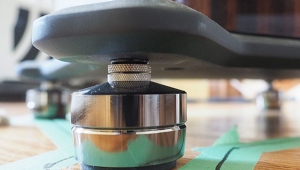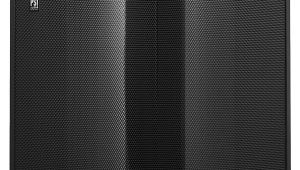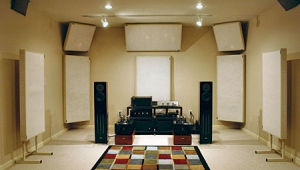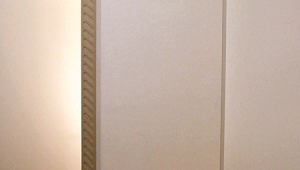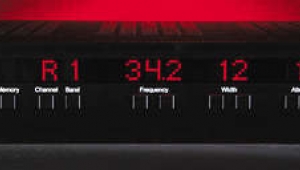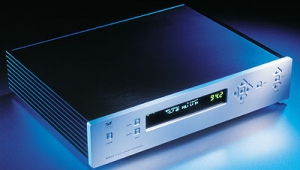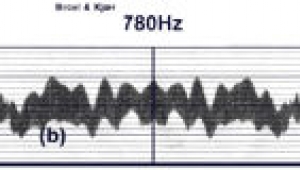| Columns Retired Columns & Blogs |
TacT Audio RCS 2.0 digital equalizer/preamplifier Measurements part 3
However, other than this behavior and the presence of power-supply-related artifacts, the TacT's D/A section offers very high performance. This is particularly notable in that it adds only $599 to the unit's price.
Footnote 1: If you look closely in fig.12, the trace below 2kHz for the left speaker is the same as the green correction filter trace in the lower part of the second "Digital Domain" screen shot in the main text of the review.
The $699 A/D module operates at 44.1kHz, 48kHz, and 96kHz sample rates, these selectable by navigating the front-panel keypad. Its input impedance was a moderate 18.6k ohms via the balanced jacks, but a low 4.6k ohms via the single-ended RCA jacks. Some capacitor-coupled, tubed phono stages might sound too lean with this low a load. The A/D frequency response was flat (not shown), and a 1.635V analog signal produced a digital level of -0.1dBFS via either set of inputs. The user should make sure his analog sources don't exceed this level; I would have liked this made easy with a simple LED ADC overload indicator on the TacT's front panel.
Although the RCS 2.0's internal data path can handle 24-bit digital words and its main digital output does put out 24-bit data, the ADC appears to be a 16-bit part. This can be seen in fig.11, which shows the A/D section's linearity error, plotted against absolute level in dBFS. (For reference, fig.12 shows the linearity error of a professional 24-bit A/D converter, plotted under conditions identical to those in fig.11.) The TacT converter is basically "deaf" to analog input signals below the 16-bit floor of -96dB. However, it is extremely unlikely that the design will be used with analog sources that have noise floors this low.

Fig.11 TacT RCS 2.0 A/D module, departure from linearity (2dB/vertical div., right channel dashed).

Fig.12 dCS 904 24-bit A/D converter, departure from linearity (2dB/vertical div., right channel dashed).
Turning, finally, to the RCS 2.0's room- and loudspeaker-correction functions: I found the user interface not particularly intuitive. While the paper documentation is skimpy, the step-by-step tutorial in the "Help" file was invaluable (though, as KR noted, it is inconvenient to have to keep toggling between it and the active program screens.) I set the TacT to correct the in-room response of the superb Revel Performa M20 minimonitors, which recently replaced the Totem Acoustic Mani-2s (see this issue's "Follow-Up") in my listening room.
The resultant curve (footnote 1) is shown in fig.13 (plotted only above 100Hz; for some reason, I couldn't get the Audio Precision System One's frequency counter to recognize frequencies lower than that in the RCS 2.0's equalized analog output). Note how well-matched the speaker-correction curves are above 1kHz, suggesting excellent pair-matching on the part of Revel. (The TacT did delay the right-hand speaker output by 0.4ms, however, due to that speaker being a couple of inches closer to the listening position.) In the midrange, the only two features noticeable are a dip between 600Hz and 900Hz (this dip a little different in detail between the two channels) and a boost at 200Hz.
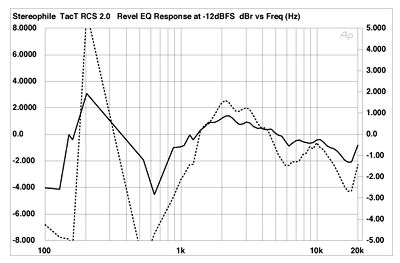
Fig.13 TacT RCS 2.0 D/A module, frequency response at -12dBFS, with correction filter set to equalize the in-room response of a pair of Revel Performa M20 loudspeakers (right channel dashed, 2dB/vertical div.).
I am always suspicious when I see a digital filter being used to apply boost. When I did my own auditioning of the correction, I was as impressed as Kal had been by the effect of the RCS 2.0 on imaging stability and naturalness of tonal qualities (once I had experimented with many, many different target curves), but I was bothered to hear what sounded like clipping on recordings that approached 0dBFS—as nearly all rock recordings do these days.
Fig.14 shows a fraction of a second's worth of the equalized waveform of one such recording, the first chorus of "This Is Me Leaving You," from Mary Chapin Carpenter's Time*Sex*Love (Columbia CK 85176). I have circled in red four instances where the equalized signal does indeed clip. The worry then becomes: Is the clipping occurring in the TacT's digital signal-processing circuitry? I played the track again, monitoring the incidence of "Overs" (digital clipping) using RME's excellent DIGICheck metering software, and reducing the RCS 2.0's gain until the signal remained below 0dBFS. This was at a volume setting of "90.5," or -3.4dB.

Fig.14 TacT RCS 2.0 digital output, waveform of Mary Chapin Carpenter's "This Is Me Leaving You" at 00:35 with fig.13 equalization applied and volume set to "93.9" (0.0dB).
Fig.15 shows the waveform of the identical passage of music. The peaks that were clipped in fig.14 are again circled in red and can now be seen to be whole. The clipping therefore doesn't occur in the TacT's DSP (footnote 2), so if a filter is developed that would otherwise result in clipping on high-level signals, the solution is to back off the RCS's volume control. I searched in vain in the skimpy literature and the onscreen Help file for any advice on this aspect of the unit's use, which to me is a serious failing. Again, a simple front-panel Over light would be a boon to the user.

Fig.15 TacT RCS 2.0 digital output, waveform of Mary Chapin Carpenter's "This Is Me Leaving You" at 00:35 with fig.13 equalization applied and volume set to "90.5" (-3.4dB).
Quibbles like this aside, I was very impressed with the TacT Audio RCS 2.0 as a practical and beneficial means of bringing effective digital signal-processing to the audiophile.—John Atkinson
Footnote 1: If you look closely in fig.12, the trace below 2kHz for the left speaker is the same as the green correction filter trace in the lower part of the second "Digital Domain" screen shot in the main text of the review.
Footnote 2: As the TacT's volume control can be set to apply up to 6dB of gain, I suspect that the DSP will indeed handle equalization boosts of up to 6dB without clipping.
- Log in or register to post comments
